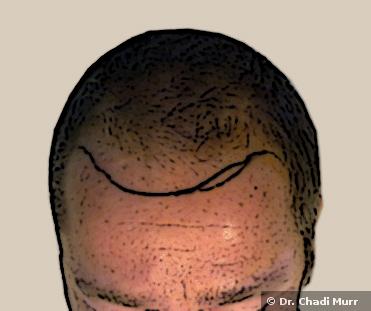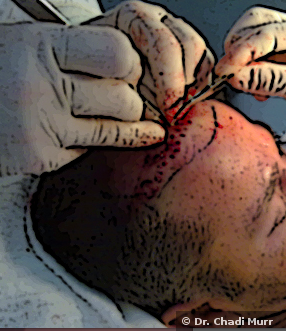Welcome to Dr. Chadi Murr
Hair Transplantation – Plastic Surgery
Hair transplantation is a surgical procedure that aims at reversing the effects of hair loss.
Hair loss affects both sexes and is, in most cases, a result of genetics. However, external factors such as stress, aging, malnutrition and sickness are also major factors of baldness.
Read MoreMale pattern baldness is manifested as a receding hairline and thinning crown, while female baldness affects the entire top of the head.
Baldness can have a devastating effect as it drastically alters a person’s appearance. For someone with thick and beautiful hair, it’s very difficult to deal with baldness and many people get the feeling of looking much older and being unattractive. Hair loss can sometimes cause negative consequences such as depression, isolation and even humiliation.
While some men and women rely on hairpieces to hide their baldness, surgery remains the best solution to restore a natural hairline and improve a person’s esthetic appearance.
Am I a good candidate?
The best candidates for hair transplant surgery are men and women who have clear and defined patterns of baldness, while other areas on their head still preserve healthy and thick hair coverage. Read More
If you are showing signs of boldness, you may be subject to a more extensive hair and therefore, you need to wait until you baldness pattern is clear before considering a surgery or else the result will be an unnatural transplanted hairline in front of your receding one.
Patients who suffer from severe hair loss that makes them almost totally bald are not good candidates for this surgery. During your consultation, the assessment will determine if you are a good candidate that can benefit from a hair transplantation surgery.

How is it done?
To give you a natural-looking hairline, I use the innovative micro-grafting technique. Prior to the surgery, it is important to mention if you are taking any medications or supplements, as some medications can cause excess bleeding and prevent the graft from surviving.
Read MoreThe surgery is usually done under general anesthesia, and can last up to six hours. It is done in two stages; the first one starts with a follicular unit extraction where a strip of skin is harvested from the back of the head in an area of healthy and dense hair growth. The excised strip is about 1cm×20 cm wide. The incision is then closed using the “trichophytic closure” technique, which allows the hair to grow through the scar and hide the wound. Meanwhile, surgery assistants start to extract individual follicular unit grafts from the strip.
Once this exercise completed, the second stage of the surgery takes place in the follicular unit transplantation. Very small blades are used to puncture the receiving site, while following a specified pattern and angling the wounds in a way to obtain a natural-looking hair pattern. The final phase consists in inserting the individual grafts into the wounds.



How long is the recovery?
After surgery, it’s normal that small rusts appear in the transplantation area. Patients should avoid scratching as this might displace the new hair follicles. The final results can be seen within 12 to 18 months. In order to protect the new hair transplants, patients are recommended to rest for at least a week.Read More
You should follow the thorough instruction list given to you to reduce the risk of complications after hair transplantation: how to care for your surgical site, what medications to take in order to relieve the pain and reduce the risk of infection, etc. Be sure to ask all the questions concerning what to expect during the recovery period.
Disclaimer: The info presented on this page is indicative and for generic use only. Each patient’s case is unique and will be studied by Dr. Chadi Murr for full assessment.
